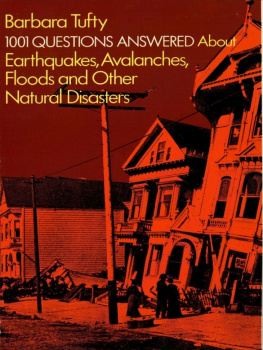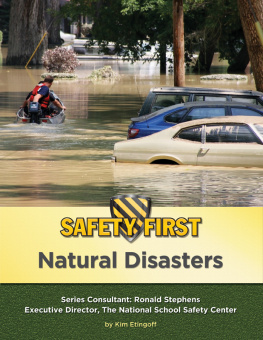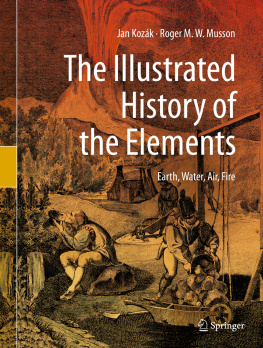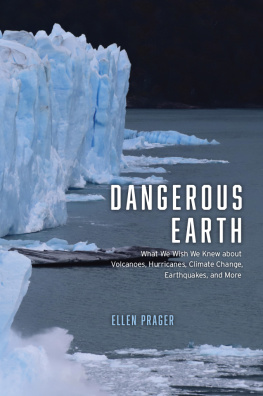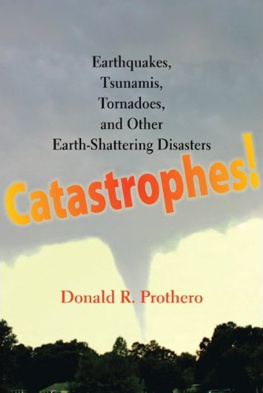THE
CURE FOR
CATASTROPHE
Hurricanes, tsunamis, earthquakes, typhoons we watch in horror before springing into action with aid and support, shocked again and again by the destructive power of the earth. Except these disasters arent only the earths doing, they are ours too.
Why did no one consider that a tsunami could disable the nuclear power plants in Fukushima? Why did so many die when Katrina flooded New Orleans? Not so long ago we could focus only on rescuing and sheltering survivors now we can anticipate many natural disasters and plan for them. In dozens of cities around the world, were able to identify the specific buildings that will be shaken apart, blown down or reduced to rubble. Yet every year, thanks to politics and inertia, we fail to act.
Traversing continents and history, Robert Muir-Wood blends gripping storytelling with scientific insights to detail our efforts to tame the most extreme forces of nature. At the frontlines, the predictive powers of new technologies mean we can foresee a future where there is an end to the pain and destruction wrought by these devastating cataclysms. As The Cure for Catastrophe makes clear, we have an extraordinary opportunity before us to make the decisions about what we build, where we live and how warnings are communicated that could save millions of lives.
Also by Robert Muir-Wood
The Dark Side of the Earth
Earthquakes and Volcanoes
THE
CURE FOR
CATASTROPHE
How We Can Stop Manufacturing Natural Disasters
Robert Muir-Wood

A Oneworld Book
First published by Oneworld Publications, 2016
This ebook published by Oneworld Publications, 2016
Copyright Robert Muir-Wood 2016
The moral right of Robert Muir-Wood to be identified as the Author of this work has been asserted by him in accordance with the Copyright, Designs, and Patents Act 1988
All rights reserved
Copyright under Berne Convention
A CIP record for this title is available from the British Library
ISBN 978-1-78607-005-0
eISBN 978-1-78607-006-7
Front cover photograph: a manufactured disaster at La Faute-sur-Mer, SW France in March 2010. Twenty-nine died in the storm surge floods, after developers built hundreds of homes in a poorly protected, high-risk flood zone.
Oneworld Publications
10 Bloomsbury Street
London WC1B 3SR
England
Stay up to date with the latest books,
special offers, and exclusive content from
Oneworld with our monthly newsletter
Sign up on our website
www.oneworld-publications.com
To my wife Elizabeth: writer, teacher, and muse
CONTENTS
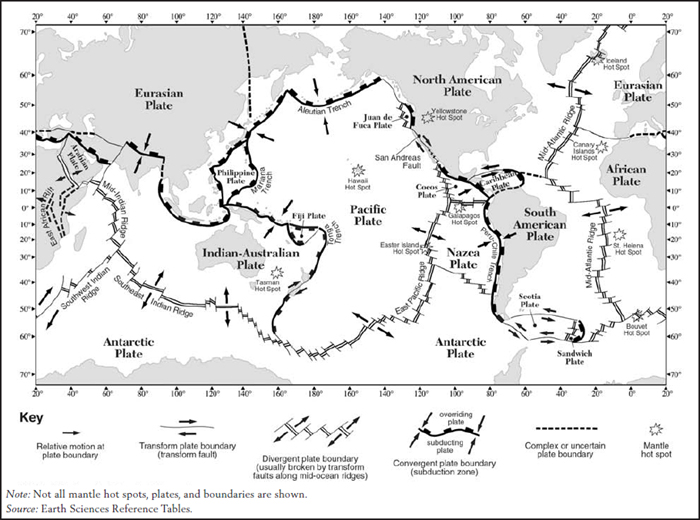
Tectonic plates
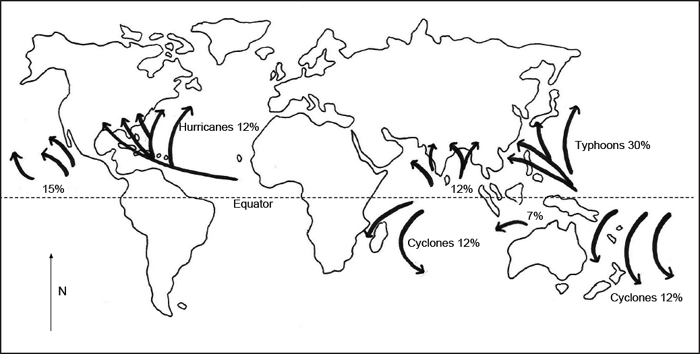
Typical tracks of tropical cyclones, regional names, and percentages of the global total of around 90 tropical cyclones each year.
INTRODUCTION
I T WAS NIGHT IN THE EARTHQUAKE-RAVAGED CITY OF EL ASNAM, Algeria. Arc lights illuminated the rubble pile. The steel bucket of the excavator screamed as it clawed at the concrete slabs. Soldiers stood listlessly, waiting to retrieve another body.
The dust swirled as the drills bored into the pancaked concrete slabs. I brushed the crumbled concrete and plaster off my clothes. I could taste the dust, feel it in my lungs. (I would taste it again the day after 9/11 on the streets around the World Trade Center.)
Next morning all was ugliness and despondency. Ruins spilled into the street. Second-floor rooms missing a wall, wallpaper torn, a childs artwork flapping, a bed covered with debris. Clothes, a saucepan, school bags, family photographs strewn in the dirtbanal and poignant mementos of ordinary lives, interrupted.
Over the years I would go on to visit towns newly blitzed by hurricanes, storm surges, tsunamis, and more earthquakes. (Dont get me wrong, this is not an obsession with destruction. I much prefer my medieval Italian hill village to be crumbling gently with age.) But you learn many things from seeing natural disaster for yourself, on the ground. Sometimes, as in New Orleans, the people have all gone. More often, as in coastal Dichato, Chile, or Bhachau, Gujarat, the survivors are camped on waste ground, their desperation palpable.
Several first questions arise in a newly ruined town: What happened? What was this destructive force? How far did it penetrate? What made some structures fall while others remained standing?
The follow-up questions emerge more slowly: Why? Why this town at this time? Was anyone aware of what lay in wait when they built the houses next to the beach? Did anyone question the idea of constructing concrete apartment buildings without an engineer? Did the villagers know what could happen when they settled high on the slopes of the volcano?
I first became intrigued by the forensics of disasters while working as the science writer on a Royal Geographical Society expedition to the Karakoram Mountains of northern Pakistan. Wanting to get deeper into the science, I volunteered to help pursue the next big disaster. Two months later came the Algerian earthquake. The first headline death toll was 20,000. The call from Cambridge seismologist Geoffrey King came through early that evening to drive a jeep down to the port at Marseilles and take the ferry to Algiers to join a small team of research seismologists.
After the adventure of the journey, we arrived in the late evening to walk the sad ruins of the city of El Asnam. Next morning we set off to install seismic recorders far away from the principal roads and towns. Each day we did the milk-rounddriving 80 miles of rutted dirt tracks to replace the car batteries powering the recorders and lift out the paper-lined drum, swarming with the butterfly wing traces of the aftershocks. (Fixed with a concoction made from crushed beetles, the paper records would be analyzed back in Cambridge.)
All the visiting researchers slept on the floor of an abandoned schoolhouse located out of the damage zone, high above a ravine. The outhouse latrine was a seat suspended over the void. In the evening we got together with French geologists and structural engineers from California, Skopje, and London who also did science after a disasterin this case, rapidly surveying why half the concrete structures in the El Asnam city centre had collapsed. The buildings in the citywhich had been reconstructed following an earthquake twenty-five years beforewere all relatively new. Why had so many of them fallen?
I went back to El Asnam on behalf of UNESCO a couple of years later to inspect trenches dug at the base of the hills. On the walls of the trenches I could trace the smoking gun: a tongue of white limestone thrust three metres over the red earth of the valley. The tongue revealed the surface trace of the fault movement that generated the vibrations that destroyed the city. Underneath was another white limestone band on top of the red soilthe fault break from the previous earthquake, radiocarbon-dated to sometime in the fourteenth century.
It seemed easy. Geologists would identify and map the dangerous faults. Trenches would be dug to reveal the incriminating evidence of the faults last shift in a big earthquake and whether it was primed for a repeat. Buildings in the vicinity of dangerous faults would be designed by engineers to remain upright through the wild earthquake ride. As the geologist Martin Capelletti said after the 1944 San Juan (Argentina) earthquake: It is within the power of builders, architects and engineers to erase earthquakes from the list of human scourges if they wish it. With the application of all this scientific knowledge, cities could be safe from disastersor so it seemedwithin a generation.
Next page


